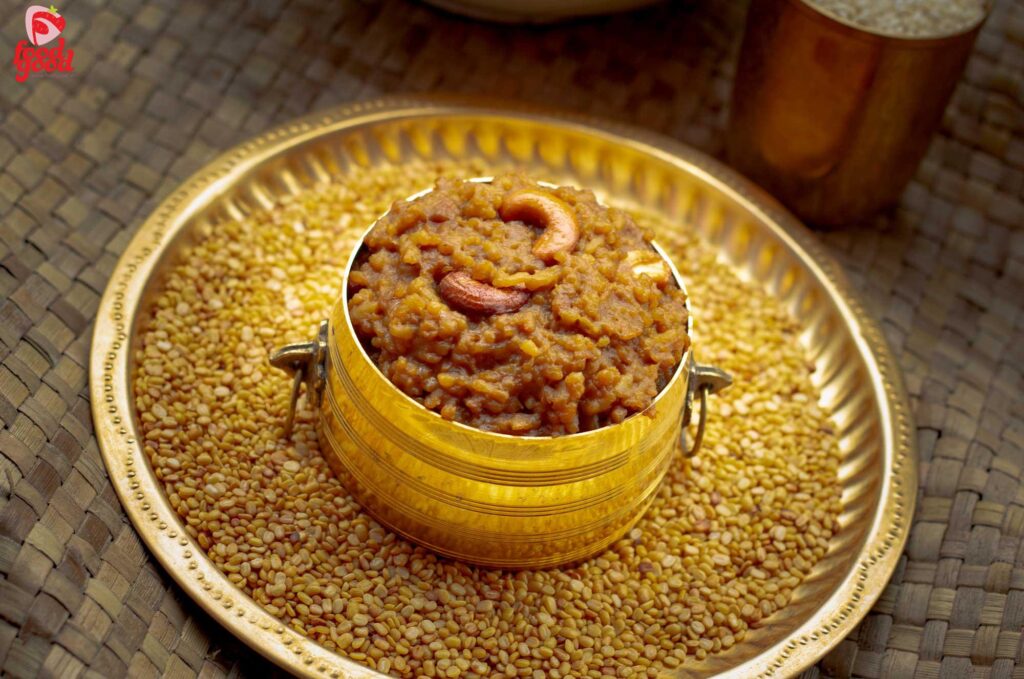There’s something special about the way the air smells during Pongal – a mix of fresh sugarcane, ghee, wood smoke, and jaggery bubbling over in wide-mouthed pots. That’s the memory that comes to me every time I make Sakkarai Pongal at home. It’s not just a sweet dish. It’s the very essence of celebration.
Sakkarai Pongal has its roots deep in Tamil culture, especially in the harvest festival of Thai Pongal, celebrated in mid-January. It marks the end of the winter solstice, the start of the sun’s journey north, and a time to thank nature – especially the Sun God and farm animals – for a good harvest. In villages, families gather in open courtyards, clay pots are tied with turmeric leaves, and milk and rice are allowed to boil over. That exact moment, when the pot spills, is met with joy – “Pongalo Pongal!” – a loud, cheerful shout that fills the sky with hope.
And then comes the part everyone waits for – the Sakkarai Pongal itself. It’s made from newly harvested rice, split moong dal, golden jaggery, and ghee. The ghee is never held back – it carries the flavour and richness right to the heart of the dish. Cashews are fried until golden, raisins puff up like tiny balloons, and everything comes together with cardamom in a thick, sticky, sweet embrace. Some temple-style versions even have a hint of edible camphor or nutmeg, adding a divine depth.
When made fresh and served hot, with a final drizzle of ghee melting over the top, there’s almost nothing more comforting. It clings to the spoon, warm and fragrant, with just the right balance of sweetness and nuttiness from the dal. It’s heavy in the best way – the kind of dish that makes you slow down and savour.
But Pongal isn’t only about sweet Sakkarai Pongal. There’s also Ven Pongal, its savory sibling – made with rice and moong dal, gently cooked and seasoned with black pepper, cumin, ginger, curry leaves, and lots of ghee. Where sakkarai pongal is festive and indulgent, ven pongal is grounding and soothing – the kind of food that hugs you from the inside. Both are often served side by side during Pongal celebrations, balancing each other perfectly.
Even today, I make sakkarai pongal not just for the festival, but on quiet mornings when I need to feel rooted – like I’m back in my grandmother’s kitchen, watching her slowly stir the pot over a wood fire, telling me that good things take time. And she was right. A dish like this may be simple in ingredients, but it carries centuries of gratitude, celebration, and joy.
Sakkarai Pongal
Ingredients
Instructions
-
Roast ½ cup moong dal in a dry pan until the raw smell disappears. Let it cool, then wash it thoroughly and set it aside.
-
Wash 1 cup of white raw rice and keep it aside.
-
In a pressure cooker, add the washed rice and moong dal together.
-
Add enough water, ½ cup milk, and a little cardamom powder.
-
Cook the mixture until soft and slightly mushy. Don’t worry if it becomes a bit overcooked, as Pongal is usually soft and mashed.
-
If it's not mushy enough, mash it gently with a spoon after cooking.
-
In a separate pan, add 1 cup of jaggery with 1 tablespoon of water. Heat it to melt completely.
-
Strain the jaggery syrup to remove impurities.
-
Add the jaggery syrup to the cooked rice-dal mixture and combine well.
-
Add ghee little by little while stirring to reach the right consistency.
-
In a small pan, melt some ghee and fry cashew nuts and raisins until golden.
-
Add the fried cashews and raisins to the Pongal and mix well. Serve warm.


